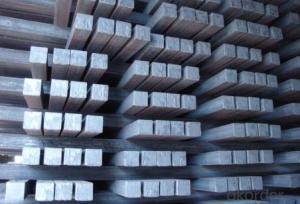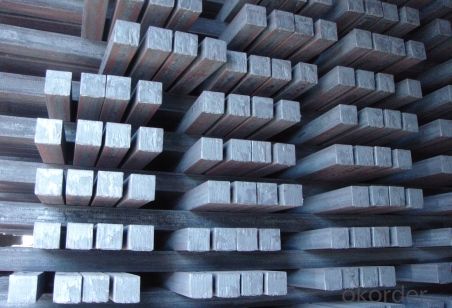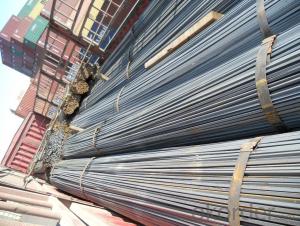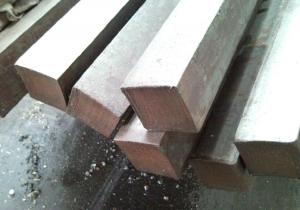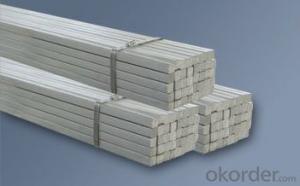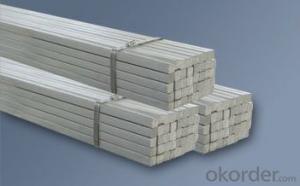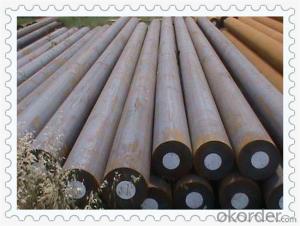Q345B High Quality Steel Square Bar
- Loading Port:
- Tianjin
- Payment Terms:
- TT OR LC
- Min Order Qty:
- 25 m.t.
- Supply Capability:
- 10000 m.t./month
OKorder Service Pledge
OKorder Financial Service
You Might Also Like
square steel billet
1.3SP, 5SP
2.terms of payment: L/C at sight
3.size: 120*120mm
4.length: 5.8~12m
square steel billet
Specifications
square steel billets
1)We procure world class quality steel billets which meets the specific requirements of the clients
The Billets produced by the company can be broadly divided into three main types i.e.
M.S. Billets
CRS Billets
Special Alloy Billets
M.S. Billets are used for rolling of TMT Re-Bars of Fe415 and Fe500 Grade and various other structural steel products.
CRS Billets are used fro rolling of CRS TMT Re-Bars.
Special Alloy Billets are used for rolling of any special grade TMT Re-Bars like Earthquake resistant TMT Re-Bars and for special grade structural steel products.
The following are the sizes of Billets available with Shyam Steel Industries Ltd.:
100 X 100
120x120
150 X 150
Physical Properties:
Description
As per IS 2830
Shyam Billets
Bend (max.) 5 mm per meter >= 5 mm per meter
Carbon (max.) 3mm per meter >= 3 mm per meter
Length 3 mt - 13 mt 3 mt - 9 mt
Chemical Properties:
Ladle Analysis:
Designation
Carbon
Manganese
C15 0.12-0.18 0.30-0.60
C18 0.15-0.21 0.30-0.60
C20 0.17-0.23 0.30-0.60
C15 MMn 0.12-0.18 0.60-1.00
C18 MMn 0.15-0.21 0.60-1.00
C20 MMn 0.17-0.23 0.60-1.00
C15 HMn 0.12-0.18 1.00-1.50
C18 HMn 0.15-0.21 1.00-1.50
C20 HMn
0.17-0.23 1.00-1.50
Billets of different designations are manufactured in three different grades namely A, B, C having sulphur, phosphorous content (on ladle analysis) and carbon equivalent as follows:
Chemical Analysis:
Grade Sulphur Phosphorous Carbon Equivalent (CE)1
Max Max Max
A 0.05 0.05 0.42
B 0.045 0.045 0.41
C 0.04 0.04 0.39
- Q: Can a steel square be used for deck building?
- Yes, a steel square can definitely be used for deck building. Steel squares, also known as framing squares or carpenter squares, are versatile tools that are commonly used in construction projects, including deck building. They are typically made of steel and have a 90-degree angle, allowing for accurate measurements and angles to be marked and cut. Steel squares are particularly useful for laying out and measuring the framing of a deck, ensuring that the corners are square and the joists are properly aligned, resulting in a structurally sound and level deck. Additionally, steel squares are durable and can withstand the rigors of outdoor construction, making them a reliable tool for deck building.
- Q: Can a steel square be used for marking out dovetail joints?
- The use of a steel square in marking out dovetail joints is indeed possible. In woodworking, a steel square is a versatile tool that is frequently employed to measure, mark, and verify the accuracy of right angles. Achieving precision and accuracy is paramount when marking out dovetail joints, and a steel square can serve as a vital reference for obtaining the correct angles and dimensions. By aligning the square with the workpiece's edges, it aids in guiding the marking of the dovetail angles and provides a straight edge for precise cutting. However, it is worth noting that, although a steel square is a helpful tool, it is advisable to complement its use with a dovetail marking gauge or a dovetail template to ensure optimal outcomes and consistent results throughout the project.
- Q: Can a steel square be used for setting up a router table?
- Yes, a steel square can be used for setting up a router table. A steel square is a useful tool for ensuring accurate measurements and angles, which are important for aligning the router table and achieving precise cuts.
- Q: How do you use a steel square to determine angles for door casing?
- To use a steel square to determine angles for door casing, you need to follow a few simple steps. 1. First, ensure that the steel square is clean and in good condition. Any dirt or damage can affect the accuracy of your measurements. 2. Place the steel square against the door casing, ensuring that one leg is flush with the horizontal surface and the other leg is aligned with the vertical surface. 3. Once the square is properly positioned, use a pencil or marker to mark the edge of the square on the casing. 4. Next, measure the angle indicated by the steel square. This can be done by reading the markings on the square's edge. The most common steel squares have markings for 45-degree and 90-degree angles, but some also have additional markings for other angles. 5. Once you have determined the angle, transfer the measurement to your door casing. Use a protractor or angle finder tool to ensure accuracy, if necessary. 6. Finally, use a saw or other appropriate tools to cut the door casing at the marked angle. Double-check the fit by placing the cut piece against the door frame to ensure a proper fit. It is important to note that using a steel square requires practice and accuracy to obtain precise angles for door casing. Taking your time, double-checking measurements, and using the appropriate tools will help you achieve the best results.
- Q: How do you use a steel square to measure board lengths?
- To use a steel square to measure board lengths, follow these steps: 1. Place the steel square on the edge of the board, aligning one side of the square with the end of the board. 2. Ensure that the square is perfectly perpendicular to the board by checking that both sides of the square are touching the board's edge. 3. Hold the square firmly against the board to prevent it from moving. 4. Look at the measurements marked on the square's blade. Most steel squares have measurements in inches, with one side measuring length and the other measuring width. 5. Read the measurement on the blade where the opposite end of the board aligns. This will give you the length of the board. 6. Take note of the measurement or mark it on the board for future reference. It's important to note that when measuring board lengths with a steel square, accuracy is crucial. Make sure the board is aligned properly with the square and that the square is securely held against the board to ensure precise measurements.
- Q: How do you use a steel square for marking and cutting mortises?
- To mark and cut mortises using a steel square, follow the steps below: 1. Choose the appropriate size steel square for your project. The steel square is comprised of two arms perpendicular to each other, with one arm being longer than the other. The longer arm is known as the blade, while the shorter arm is referred to as the tongue. 2. Use a tape measure or ruler to measure the width of the mortise you intend to cut. Once you have determined the measurement, align the blade of the steel square with the wood's edge where you want the mortise to begin. 3. Firmly hold the steel square against the wood, ensuring that the blade is flush with the edge. Use a pencil or marking knife to mark a line along the tongue of the square, indicating the starting point of the mortise. 4. Proceed to measure the depth of the mortise. To accomplish this, position the square vertically against the wood's side, with the tongue against the top surface. Slide the square downwards until the blade reaches the desired depth. Mark this measurement on the wood's side using a pencil or marking knife. 5. Repeat this procedure on the opposite side of the wood to mark the other edge of the mortise. 6. Once you have accurately marked the starting point and depth of the mortise on both edges, utilize a chisel and mallet to commence the cutting process. Begin by making a series of shallow cuts along the marked lines, gradually increasing the depth with each pass. Take your time and exercise caution to ensure precise and clean cuts. 7. As you progress, periodically check the depth of the mortise against the marked measurement on the steel square. This will aid in maintaining the desired depth throughout the cutting process. Always remember to wear appropriate safety equipment, such as goggles and gloves, when working with chisels and other cutting tools. Additionally, practice on scrap wood before proceeding to your actual project in order to become familiar with the process and refine your skills.
- Q: How do you determine the squareness of a steel square?
- To determine the squareness of a steel square, you can use a reliable reference square or a precision measurement tool like a squareness gauge. Place the steel square against a straight edge and check if the perpendicular edges align perfectly with the reference square or gauge. If there is any deviation or gap between the edges, it indicates a lack of squareness.
- Q: Can a steel square be used for making parallel lines?
- Indeed, the utilization of a steel square is feasible for the creation of parallel lines. This multifunctional instrument comprises of a linear border and a ninety-degree angle. Through aligning the linear border of the steel square with a designated line of reference, it is plausible to generate an additional line that runs parallel to the aforementioned reference line. The ninety-degree angle of the steel square guarantees that the newly crafted line will be perpendicular to the reference line, thus resulting in parallel lines. Consequently, the steel square proves to be an advantageous implement within a multitude of domains, including carpentry, construction, and drafting.
- Q: Can a steel square be used for woodworking projects?
- Woodworking projects can indeed utilize a steel square. Although traditionally constructed from wood, a steel square boasts various advantages for woodworking endeavors. Its sturdiness and resistance to deterioration surpass those of its wooden counterpart, guaranteeing prolonged accuracy and precision. Furthermore, steel squares often incorporate laser-etched measurements and angles, facilitating meticulous calculations and precise marking of cuts. Moreover, steel squares exhibit greater resistance to warping or deformation caused by fluctuations in humidity or temperature, thereby ensuring consistent measurements. Nevertheless, it is important to acknowledge that steel squares may possess a weightier disposition than their wooden counterparts, potentially impacting ease of use and portability. Nevertheless, numerous woodworkers opt for steel squares due to their unwavering durability and accuracy.
- Q: Can a steel square be used for checking the alignment of a door frame?
- Yes, a steel square can be used for checking the alignment of a door frame. It can be used to ensure that the corners of the door frame are square and that the sides are perpendicular.
Send your message to us
Q345B High Quality Steel Square Bar
- Loading Port:
- Tianjin
- Payment Terms:
- TT OR LC
- Min Order Qty:
- 25 m.t.
- Supply Capability:
- 10000 m.t./month
OKorder Service Pledge
OKorder Financial Service
Similar products
Hot products
Hot Searches
Related keywords
